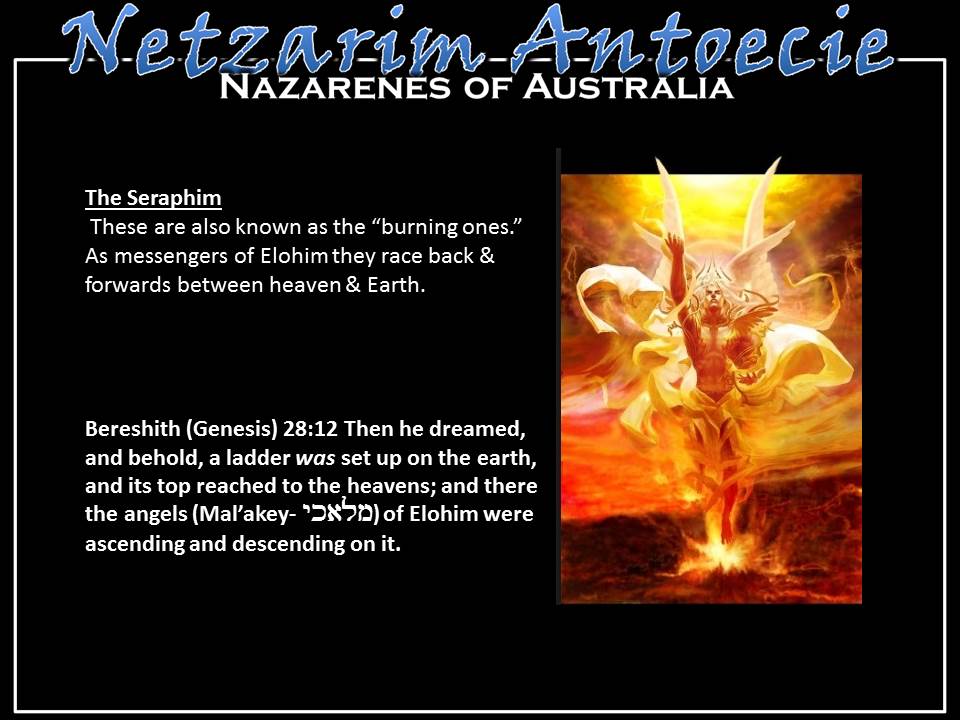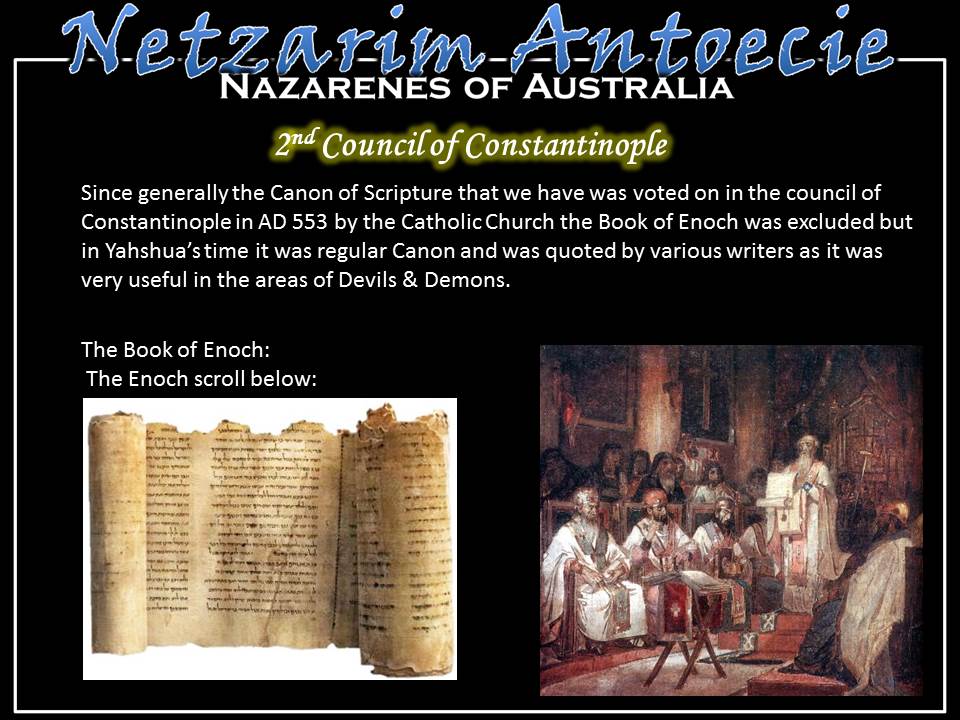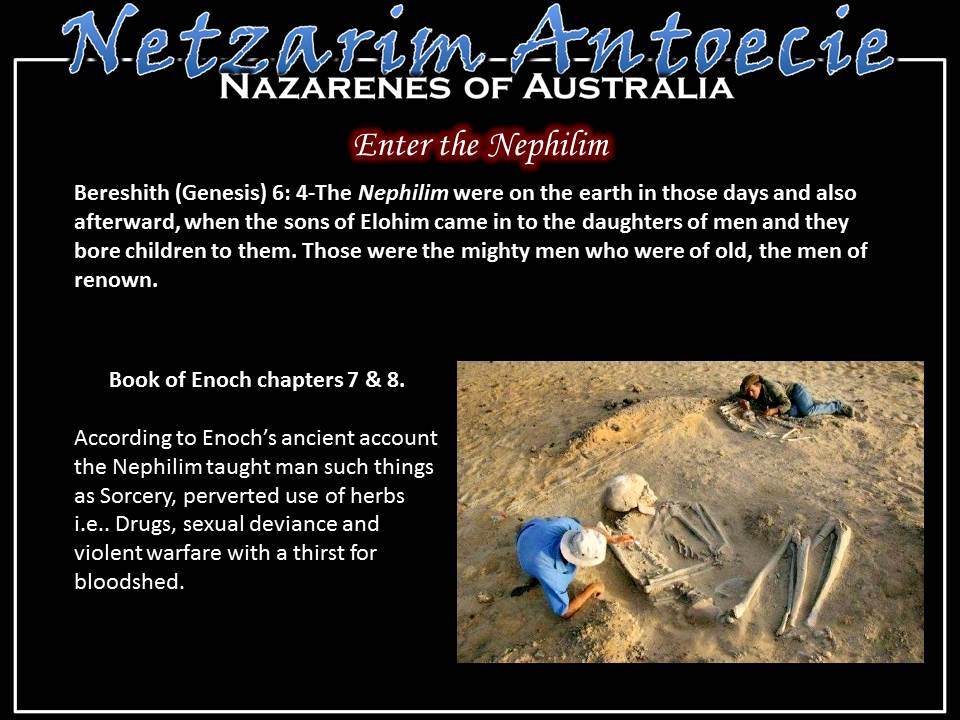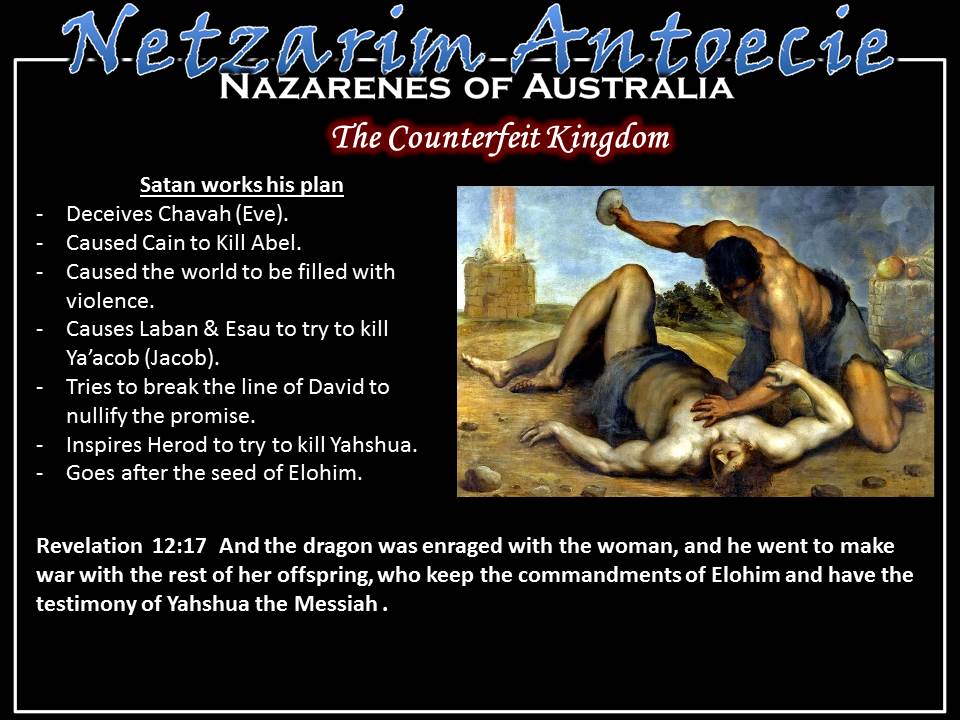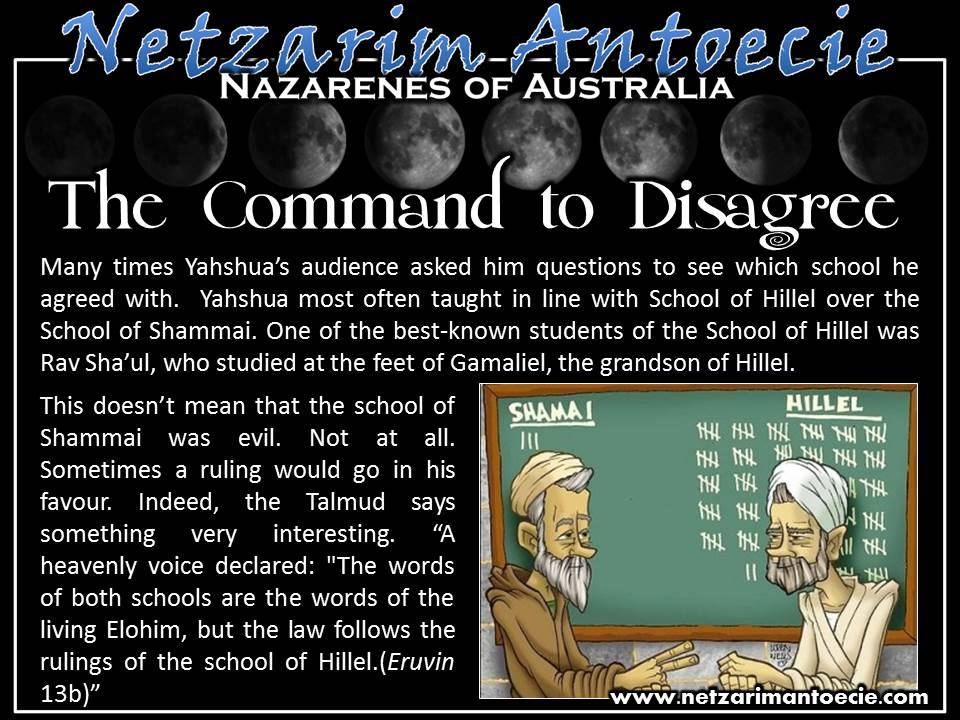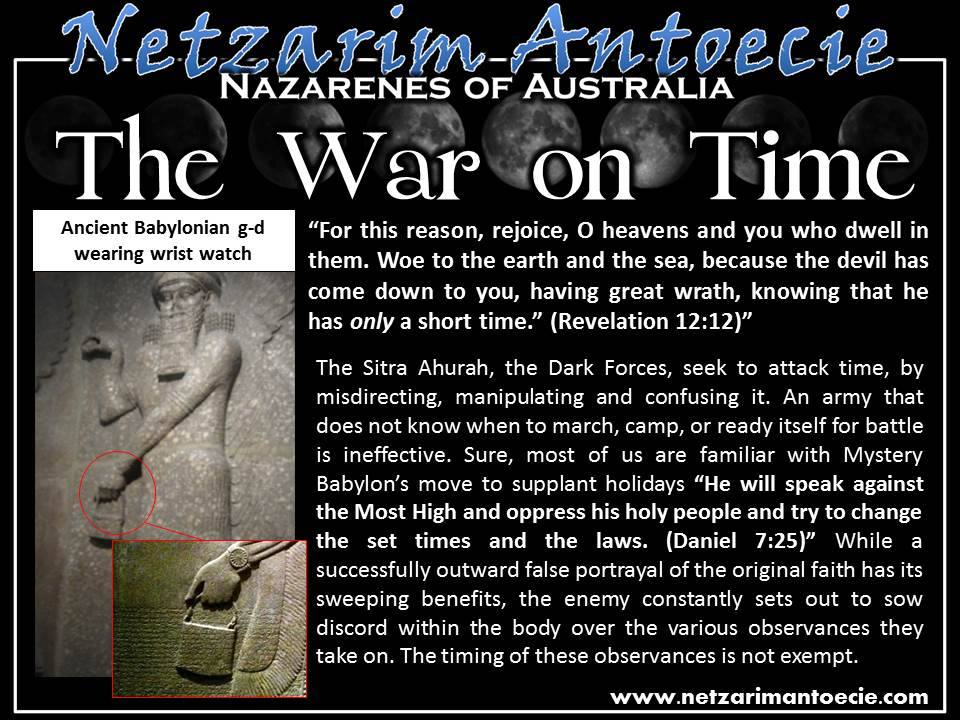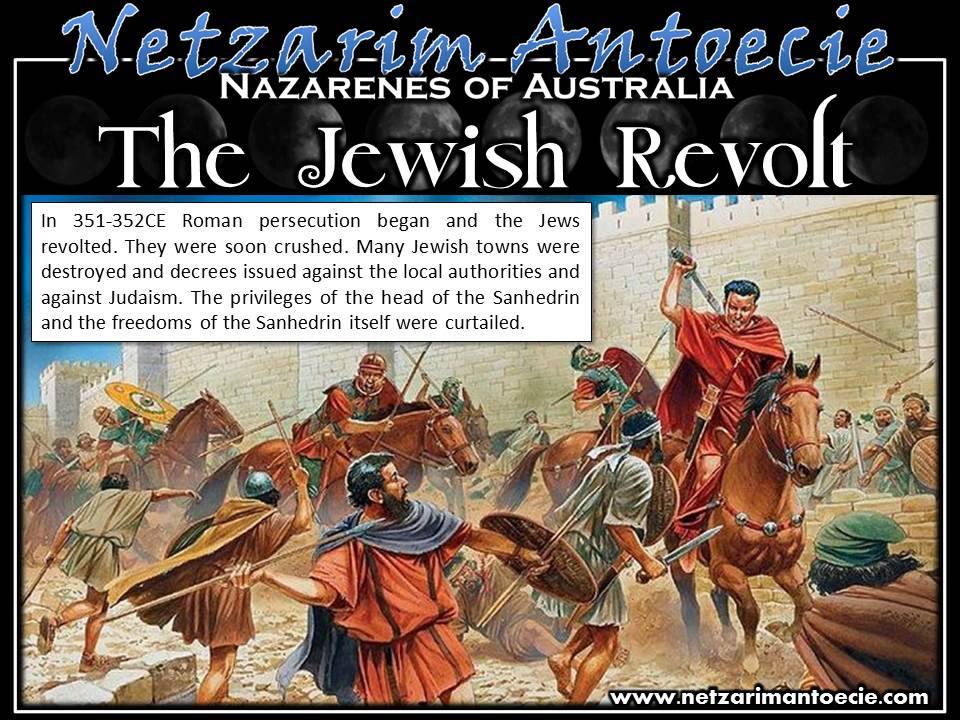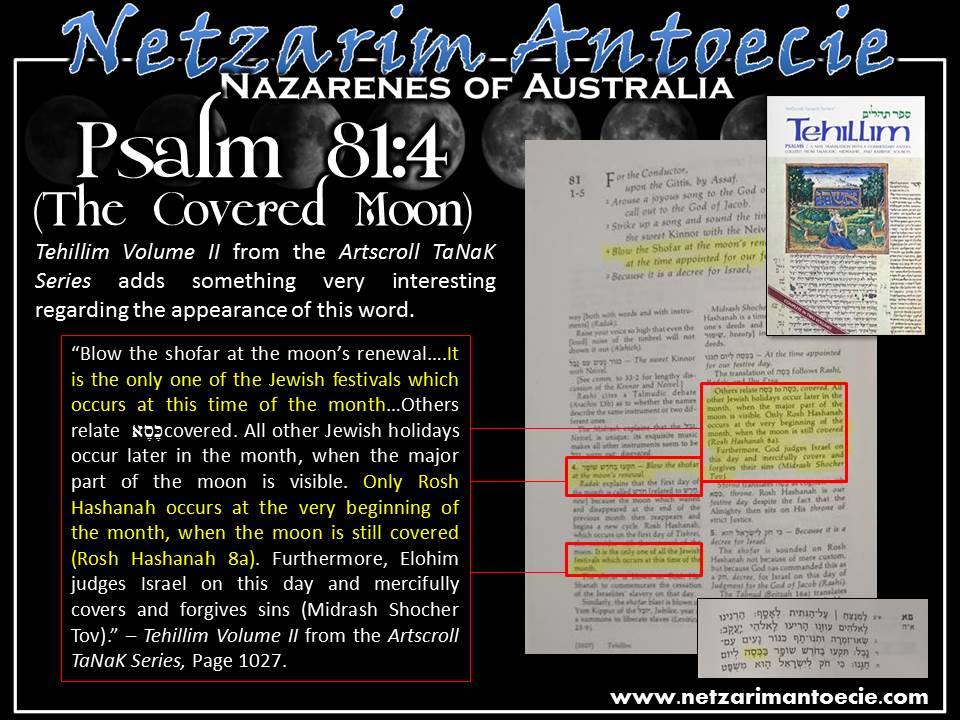Part 3 Segment 2
Slides
Study Notes
Lost in Translation Part 3- Enter the Dragon
Aim: The purpose of this discussion is to examine an area of understanding that is very often overlooked but is highly important. We have studied in Part 1 & 2 how YAHWEH our Elohim from the time of Adam & Chavah (Eve) was drawing his people back into intimacy through the establishment of the various Covenants. Today we will look at how another Kingdom is working in total opposition to the glorious Kingdom of YAHWEH though we know the end result will be the establishment of an Eternal Kingdom under YAHWEH & his Kingdom will prevail & endure forever and ever.
Slide 2
In the Beginning
Even before the Creation of the Heavens & the Earth Scripture teaches us that Elohim was, and all the Heavenly beings were created. We read the following words from YAHWEH the Elohim of all Creation painting a glorious picture of the Creation:
Iyob (Job) 38:4-7 “Where were you when I laid the foundations of the earth?
Tell Me, if you have understanding. 5 Who determined its measurements?
Surely you know! Or who stretched the line upon it? 6 To what were its foundations fastened? Or who laid its cornerstone, 7 When the morning stars sang together, And all the sons of Elohim shouted for joy?
From these words we can see that the Creation was wonderful, filled with so much perfection that all the created Malakim (Angels) rejoiced over the work of Elohim. Heylel in Hebrew or Lucifer as he is called was truly the most blessed of all the sons of Elohim.
Ezekiel 28:14 “You were the anointed cherub who covers (the Throne of Elohim); I established you; You were on the holy mountain of Elohim; You walked back and forth in the midst of fiery stones.
Slide 4
However by the hand of Heylel (Lucifer) a rebellion in Heaven took place & its implications are still felt today:
Ezekiel 28:15 “You were perfect in your ways from the day you were created, until unrighteousness was found in you. 16“By the greatness of your trade you became filled with violence within and you sinned. So I thrust you from the mountain of Elohim and I destroyed you, O covering cherub, from the midst of the stones of fire. 17“Your heart was lifted up because of your loveliness; you corrupted your wisdom for the sake of your splendour. I threw you to the earth,
Slide 5
Elohim & his order of beings
To fully grasp the truths of this rebellion we need to understand the order of Ministering Spirits or Malakim. They were divided into three groups:
1. The Cherubim- commonly called Archangels who are the highest & most powerful. They literally surround the throne of Elohim. They have six wings, four faces & are quite large. With the help of the Talmud, Mishnah & the Apocryphal books we know six Cherubim.
- Michael- Warrior prince of Elohim.
- Gabriel- Redeemer of Elohim.
- Raphael- Bringer of the healing of Elohim.
- Uriel- Light of El or bringer of El’s light.
- Abaddon- who originally was the Cherub of life and is now the Cherub of Death.
- Ha Satan- who is known as “Heylel” in Hebrew or “Lucifer” by the Babylonians
but this may be more a description than his name.
Note: The term Covering Cherub could also refer to Covenant which can be thought of as a covering as with the “chuppah” the literal covering so central to a Hebrew Wedding. Since names embody identity it is possible that Elohim stripped these two fallen Malakim of their names as all the rest have an identity with El in their names.Slide 6
2. The Seraphim- who are also known as the “burning ones.” As messengers of Elohim they race back & forwards between heaven & Earth. In Revelation 8:7 the term for fire is Seraph while the term for normal fire is “esh” therefore this may refer to Seraphim.
It is thought that the Malakim (Angels) on Ya’acob’s ladder (Jacob’s ladder) were these in Bereshith (Genesis) 28:12.
Note: In YAHUchanan (John) 1:51 Yahshua said “Truly truly I say to you, you shall see the Heavens opened and the Malakim (Angels) of Elohim ascending and descending on the son of Man.
By implication Yahshua is telling Nathan’EL (Nathaniel) that he is the ladder between Heaven & Earth.
Slide 7
3. The Teraphim- These are the ones who can take on Human form. According to Hebrews 13:2 you may even entertain them. Teraphim are also denoted by the
Hebrew term “ayir” meaning watchers – Dani’el 4:10, 17 & 18.
This type of angel invariably appears as a human man in appearance, sometimes shining with light or fire. They are known by their job description in many cases. In Daniel 4 a messenger angel is referred to 3x as a “watcher, a holy one”, who delivered a message in a dream. They are always described to look like men, and are never described as having wings or to be female.
Note: The term “Idols” that Rachel took from Laban in Bereshith (Genesis) 31:34 comes from a Hebrew word for idols and images being “Ha Teraphim” suggesting that there are Spirits behind carved figures that are used in all Pagan Religions.
Slide 8
The Counterfeit Kingdom of Ha Satan
From the time Adam was placed in gan Eden (the garden of Eden) to work it & to Guard it as he was given rule over all creatures moving upon the face of Ha Eretz (the Earth) Satan began to work his plan to defeat the plans of Elohim.
- Satan deceived Chavah (Eve) to cause Man to sin therefore Adam lost his authority.
- Satan caused Cain to kill Hebel (Abel).
- Satan caused the World to be filled with violence resulting in the flood.
- Satan caused Laban & Esau to desire to kill Ya’acob (Jacob) to defeat the
promises of Elohim.
- Satan tries to break the line of David to nullify the promise.
- Even causing Herod to try to kill Yahshua.
- Finally because he could not defeat Yahshua we read:
Revelation 12:17 And the dragon was enraged with the woman, and he went to make war with the rest of her offspring, who keep the commandments of Elohim and have the testimony of Yahshua the Messiah.
After man’s fall we read what YAHWEH Elohim of all creation said to the serpent:
Bereshith (Genesis) 3:15 And I will put enmity between you and the woman, And between your seed and her Seed; He shall bruise your head, And you shall bruise His heel.”
Though one widely held view is that this is a reference to the Messiah it can also mean that Elohim is prophesying about two sets of offspring, Satan’s and Man’s since the Hebrew word used is “zarah” for both but these are not spiritual but physical descendants.
Blue letter Bible- H2233Zera- seed, offspring, descendants, posterity.
Slide 9
Since generally the Canon of Scripture that we have was voted on in the council of Constantinople in AD 553 by the Catholic Church the Book of Enoch was excluded but in Yahshua’s time it was regular Canon and was quoted by various writers as it was very useful in the areas of Devils & Demons.
Slide 10
Enter the Nephilim
The saga found in Bereshith (Genesis) 6 details what happened next:
Bereshith (Genesis) 6: 4-The Nephilim were on the earth in those days and also afterward, when the sons of Elohim came into the daughters of men and they bore children to them. Those were the mighty men who were of old, the men of renown.
The book of Enoch however in Chapters 7 & 8 gives the rest of the story, with a group of 200 of Satan’s fallen Teraphim (Angels) led by one named “Samyaza”, who took on human form, took the daughters of men to produce hybrid giant offspring of Devils & Humans called Nephilim.
According to Enoch’s ancient account the Nephilim taught man such things as Sorcery, perverted use of herbs i.e. Drugs, sexual deviance and violent warfare with a thirst for bloodshed.
From all this we come to see a new truth as to why YAHWEH Elohim of Creation brought the flood. It was to destroy the Nephilim and all those tainted with the seed of Satan who desired to pollute the whole gene pool of the Earth. YAHWEH was therefore saving mankind from total corruption. Noah’s Family therefore was not the only righteous family but also the only pure human Family made in the image of Elohim.
Elohim therefore purified the Earth but the result was that since the Nephilim were half Devil their souls lived on seeking habitation. After the flood however they did re-establish themselves.
This may help us understand why YAHWEH ordered the destruction of the Canaanites since scripture speaks of Nephilim or Giants in the land of Canaan and even in King David’s time we read about them the most prominent being Goliath.
Slide 11
A Hebrew word for “Demon” is “Nefsheraa” a compound word coming from” Nefesh- animal soul.
Raa- evil.
Therefore the meaning we have is an “evil animal soul” but can be translated as “a disembodied soul, deformed, wicked, hungry or evil.
Interestingly the term “Chai” meaning life or living thing can be written in various ways but when it refers to the Nephilim its spelling does not include the “yod” which implies the work of Elohim because his work & spirit are completely absent. The result is that it is often then translated as an evil Beast.
We read in the Brit Chadashah (New Testament) words that imply persons of similar nature than those of the Nephilim in 2 Kepha (Peter) & Yahudah (Jude):
2 Kepha (Peter) 2:12 But these, like natural unreasoning beasts, having been born to be caught and destroyed, blaspheme that which they do not know, shall be destroyed in their destruction,
Kepha (Peter) surely is talking of persons that are not made in the image of Elohim but exhibit a satanic seed in their hearts. Is it possible that through the progress of time that Ha Satan (Satan) is continuing with his plan to corrupt the World?
Slide 12
How does this Knowledge affect us
Now that we know that Demons are these souls striving for their lost humanity we can see why much of Yahshua’s ministry and that of his Talmidim (Disciples) was Deliverance. There are many accounts in the Scriptures of Demoniacs being delivered through Yahshua’s ministry, his Disciples as well as Philip in Samaria & Sha’ul (Paul) in his travels to all the cities he visited.
Today it is still no different as Demons desire to feel our fear, our hate, our pain, our lust or any human emotion the stronger the better. They control their host to create intense sensation.
The truth however is that all believers have authority over them but only in the name of Yahshua. The Demons will try to convince us otherwise so we need to be aware of their prodding’s & be led by the RUACH HA KODESH (Holy Spirit) not giving Satan any room.
In the Book of Mark we find a great promise to all who believe:
Mark 16:17 And these signs shall accompany the ones who believe: In My Name they shall cast out demons, they shall speak with renewed tongues, 18 they shall take up snakes and if they drink any deadly drink it shall by no means hurt them, they shall lay hands on the sick and they shall get well.”
From this we notice that the casting out of Demons is the 1st in this list so we need to believe the same holds for us that if we can believe we will do the same as Yahshua and his Talmidim (Disciples) did by the power we have been given in his name.
Slide 13
We find an interesting story in the Nazarene Scriptures (New Testament) that will teach us some great truths:
Yahshua has just come down from the Mountain after being transfigured before Kepha (Peter), Yaakov (James) & Yahuchanan (John) while the rest of his Talmidim (Disciples) waited at the bottom of the Mountain:
Mark 9:17-20 Then one of the crowd answered and said, “Teacher, I brought You my son, who has a mute spirit. 18 And wherever it seizes him, it throws him down; he foams at the mouth, gnashes his teeth, and becomes rigid. So I spoke to Your disciples, that they should cast it out, but they could not.”
19 He answered him and said, “O faithless generation, how long shall I be with you? How long shall I bear with you? Bring him to Me.” 20 Then they brought him to Him. And when he saw Him, immediately the spirit convulsed him, and he fell on the ground and wallowed, foaming at the mouth.
The disciples that remained at the bottom of the Mountain had thought that they could deliver this boy from the mute Spirit as they had seen Yahshua delivering people many times so they knew the process and the words used but to no avail. When Yahshua said “O faithless generation how long shall I be with you” I believe he was speaking directly to his Talmidim (Disciples) more so than the crowd.
Slide 14
We find a truth in the following that absolutely affects us today just as it did the Talmidim who had seen him deliver & heal many people even though they could not deliver this boy:
In MattithYAHU (Matthew) 17:19-20 Then the disciples came to Yahshua privately and said, “Why could we not cast it out?”
20 So Yahshua said to them, “Because of your unbelief; for assuredly, I say to you, if you have faith as a mustard seed, you will say to this mountain, ‘Move from here to there,’ and it will move; and nothing will be impossible for you.
Here we see that the big issue was their lack of faith. The unclean spirit knew they doubted so without confidence in their authority the unclean Spirit would not come out. It was not lack of Torah that prevented the disciples from exercising their authority but it was lack of faith. Is it not the same with us?
If Yahshua has said for us to go and do as he did then we know we need to work on the area of faith without neglecting the Study of the Torah and Scriptures. Sadly many people today also neglect Torah which opens the Door to the power of the enemy. Torah could be thought of as a hedge of protection but through misunderstanding of Scripture many people now suffer more than is necessary:
Slide 15
Iyob (Job) 1: 8-9 Then YAHWEH said to Satan, “Have you considered My servant Job, that there is none like him on the earth, a blameless and upright man, one who fears Elohim and shuns evil?”
9 So Satan answered YAHWEH and said, “Does Job fear Elohim for nothing? 10 Have You not made a hedge around him, around his household, and around all that he has on every side? You have blessed the work of his hands, and his possessions have increased in the land.
Job was truly protected by his righteous living as was his entire household which should encourage us and was only tested because YAHWEH knew his faith would keep him from sinning.
Slide 16
The Most Vital Key to Success
In Mark 9 however we also learn that just like an army, Demons have higher ranks because we find something added which I prefer to take from the “Kings Covenant Version” as it gives us better insight:
Mark 9:29 Yahshua said to them, "This kind will come out by nothing except by one who practices intense prayer and fasting." [Kings Covenant Version]
What this teaches is firstly that there are different kinds of unclean spirits, ones that are easier to deal with therefore a lower rank and ones that are of a higher rank & require more strength in the anointing and faith. Secondly it teaches that to be effective the disciples and us need to be a diligent people of intense prayer and even fasting when there is a great battle to be fought.
Slide 17
Sha’ul (Paul) teaches us about our struggle in:
Ephesians 6:12 Finally be strong in the Master and in his mighty power. Put on the full armour of Elohim so that you can take your stand against the devil’s schemes because we do not wrestle against flesh and blood, but against principalities, against authorities, against the world-rulers of the darkness of this age, against spiritual beings of wickedness in the heavenlies.
Slide 18
An End time Prophecy
In the words of Yahshua however we find a prophecy that as we think about the world today could be coming into effect at this moment in time. It is found in:
Luke 17:26-27 And as it came to be in the days of Noah, so also shall it be in the days of the Son of Adam: 27 “They were eating, they were drinking, they were marrying, they were given in marriage, until the day that Noah went into the ark and the flood came and destroyed them all.
When we look to this passage we would normally understand it as a time when people are not ready and just going about their normal lives but when has there ever been a time when people didn’t eat, drink or marry. How can this be a unique sign to tip us off about Yahshua’s coming?
Slide 19
The words which translators got “they” were the Hebrew words “baal” or devils and “nashim” or women. Therefore we could read it like this: “as it was in the days of Noah when Devils and women were given in marriage.”
This makes perfect contextual sense. If we look to the World today are we not seeing that the same is happening and as in the days of Noah when the World was full of violence etc just like what the Book of Enoch describes with regards the world in Noah’s day? YAHWEH will not put up with it and surely will end it once and for all! This understanding though very different to what was thought, is surely worthy of consideration.
Slide 20
There is second witness of support from the book of Daniel for this line of thinking however:
Dani’el 2:43-44 And as you saw iron mixed with muddy clay, they are mixing themselves with the seed of men [in marriage bonds], but they are not clinging to each other [as with different ideologies], even as iron does not mix with clay. 44“And in the days of these sovereigns [Mighty ones] the Elah of the heavens shall set up a reign which shall never be destroyed, nor the reign pass on to other people – it crushes and puts to an end all these reigns and it shall stand forever.
Since Dani’el talks about the Statue in his vision referring to the four evil Kingdoms of Gold, Silver, Bronze and Iron as well as the feet of Iron mixed with Clay most think it refers to Babylon, Medo-Persia and Greece with the last being Rome or in the future the final one being ruled by the beast or the Anti-Messiah.
Slide 21
There is however something more if we see it through Hebraic symbology which views clay as a sign of man since “adamah” from which we get Adam refers to clay or soil. Iron however is a sign of Angelic beings.
Are we reading too much into all this? You be the judge because if we are not then this could be the sign of the Kingdom of the Anti- Messiah and the Nephilim need not be giants based on the knowledge of the meaning of the Word “Nephal” which can mean “a living abortion” or “to fall to the ground” therefore the fallen ones.
Slide 22
The End of the Matter
We have previously studied how YAHWEH had a divine plan to bring us into deep fellowship of his design but we know the enemy from the beginning had his plan that will not end but will intensify as the day of Yahshua’s return draws near. As Netzarim it is to our advantage to understand the times and not be dismayed, for in Yahshua Ha Mashiach (the Messiah) we need to understand that we have the victory and by faith we walk, knowing our enemy walks around seeking whom he may destroy. We however need to know our enemy, with all his strategies so that we can stand strong. Through his forces he will attack the body of Mashiach (the Q’hilath - the Assembly) and especially those in positions of teaching & leadership.
Knowing that in the World we will have tribulations we must be of good cheer because Yahshua has overcome the world. To this end let us stand united together lest any of us fall. May we all bring praise to YAHWEH and to YAHSHUA his son who is our beloved King and long awaited Bridegroom who will be victorious over all his enemies!
Baruch Atar YAHWEH. Amein.



